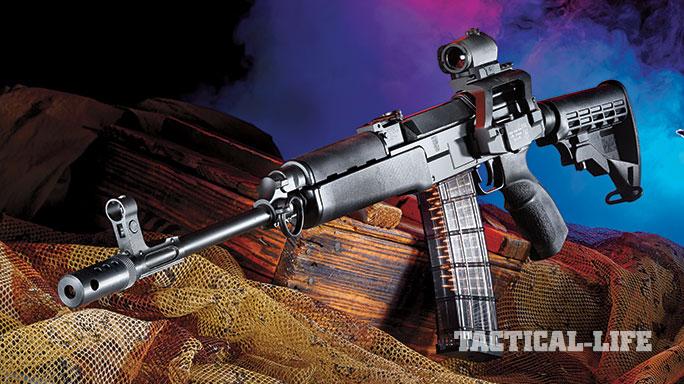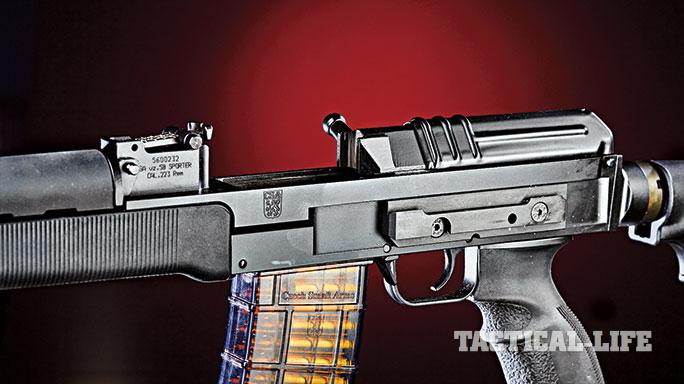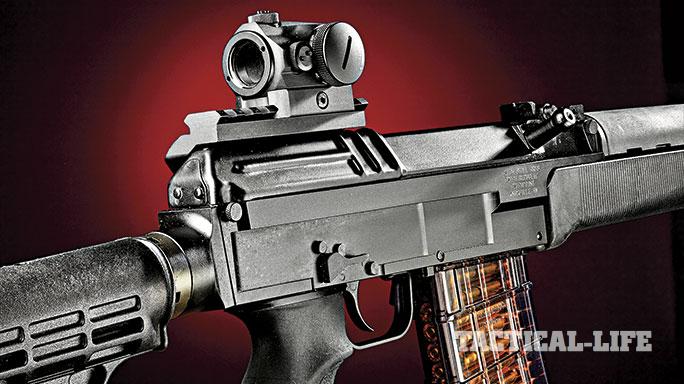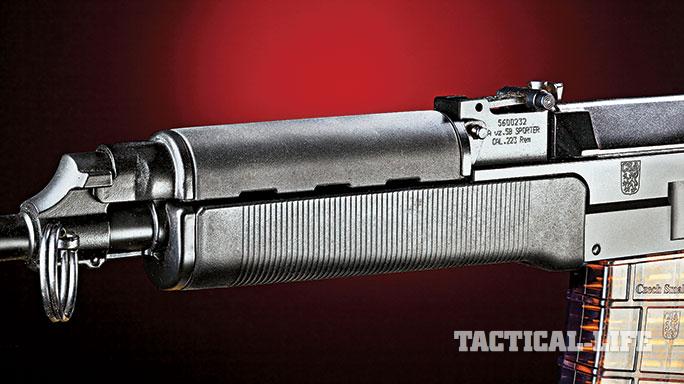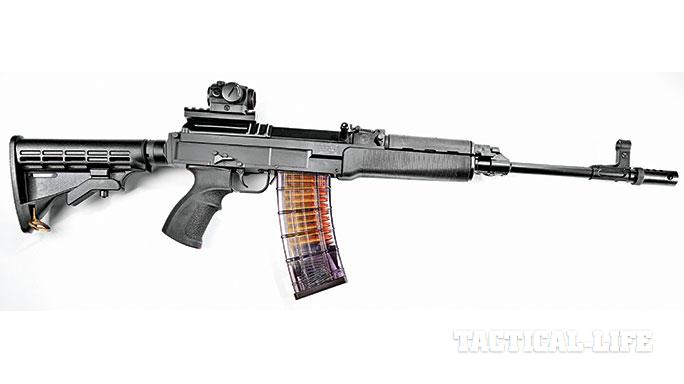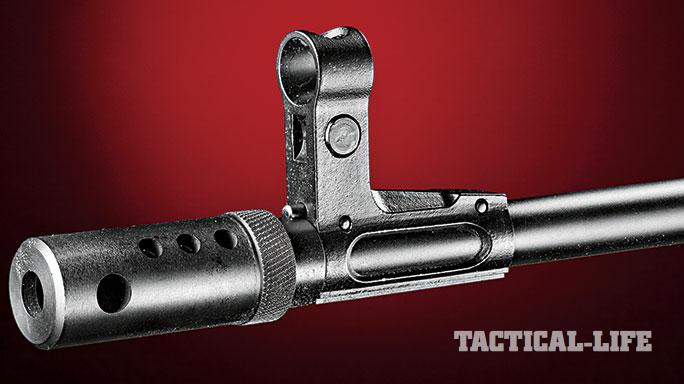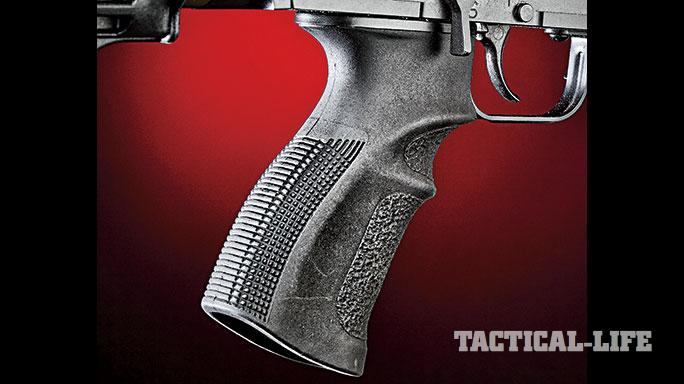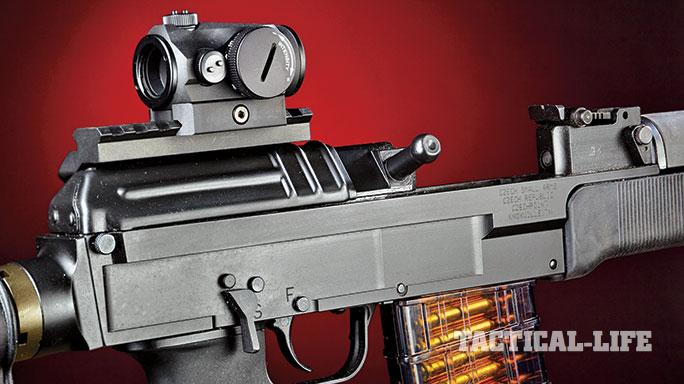The central European nation of Czechoslovakia had been part of the Austro-Hungarian Empire since the 1520s, but in the aftermath of World War I it regained its independence. An industrial center since the 17th century, Czechoslovakia was known for its high-quality small arms, and in 1919 Ceská Zbrojovka (better known as CZ) was established and quickly became a major player in the post-war international small-arms market.
- RELATED: Czechpoint’s Scorpion Is a New Take on the Cold War 7.65mm Vz. 61
- RELATED: Megapistols: 7 Big Firearms in Small Packages – CzechPoint SA Vz. 58 5.56mm
After a Soviet-backed coup in 1948, Czechoslovakia became a Russian satellite state and joined the Warsaw Pact. But the country maintained its tradition of issuing its armed forces Czech designed and manufactured weapons. In preference to the Soviet SKS carbine, in 1952 it adopted a CZ-designed semi-auto rifle, the 7.62mm Samonabíjecí puška vzor 52, which fired a proprietary cartridge—the 7.62mm náboj vzor 52.
Five years later, bowing to Soviet pressure for standardization, most vzor 52 rifles were converted to fire the Soviet 7.62mm patron obr. 1943g (7.62x39mm), known in Czechoslovak service as the 7.62mm náboj vzor 43.
Advertisement — Continue Reading Below
The USSR pressured all Warsaw Pact armies to standardize on Soviet-pattern weapons, which, when it came to shoulder-fired arms, meant the AK. While most Eastern Bloc armies toed the line, the Czechs refused. In 1956, a design team led by CZ’s chief engineer, Jiri Cermák, designed a select-fire rifle that could do everything the AK could, but better.
While the resulting 7.62mm samopal vzor 58 (7.62mm Submachine Gun Model 58) aped the outward appearance of the Kalashnikov with a slab-sided receiver, curved 30-round magazine, exposed barrel and pistol grip, it was mechanically quite different.
The AK operates by venting gases from the barrel that move a gas piston affixed to the bolt carrier rearward, rotating and unlocking the bolt before pushing it to the rear; this extracts and ejects the fired cartridge case and cocks the hammer. The recoil spring pushes it forward, stripping the next round from the magazine and chambering it as the bolt is rotated once again, locking it into battery.
Advertisement — Continue Reading Below
The vzor 58 also uses gases bled into a cylinder above the barrel to push a chromium-plated piston rearward, where it impacts the bolt carrier and drives it to the rear while the piston is pulled forward by a separate spring. The gas cylinder is then vented and the remaining gases are exhausted into the atmosphere via two ports in the cylinder.
A wedge on the bolt carrier lifts the pivoting locking breech block out of recesses in the receiver, allowing the entire unit to move rearward, extracting and ejecting the spent cartridge case while cocking the striker. The recoil spring then pushes the bolt carrier forward, stripping the next round from the magazine and chambering it as the breech block is cammed down, locking it to the receiver. Where the AK-47 used a pivoting hammer, the vzor 58 utilized a straight-line striker to fire the cartridge.
The vzor 58’s receiver was machined from solid steel and the AK’s awkward safety/selector lever was replaced by a conveniently located rotating switch on the right side of the receiver, which is easier—and quieter—in operation.
Advertisement — Continue Reading Below
In the forward position, the bolt carrier seals the entire receiver, keeping debris out of the action. Unlike AK-type weapons, the vzor 58’s bolt locks open when the magazine is empty, and there is a bolt hold-open catch located next to the paddle-shaped magazine release.
Battle Tested
The vzor 58 entered service in late 1959. Reportedly, they were first seen in combat during the genocidal Nigerian Civil War (1967-1970), while others showed up in the hands of the Viet Cong and North Vietnamese during the conflict in Vietnam. Eventually, Soviet proxies in Asia, Africa and Latin America received them, and they also saw wide use by militants in the Middle East.
Advertisement — Continue Reading Below
After the collapse of the USSR, the Czechs began divesting themselves of large stockpiles of older weaponry, and vzor 58s began showing up in just about any trouble spot around the globe where Soviet-caliber small arms were common. So, it is not surprising that large numbers of them are being used in Afghanistan and Iraq.
In 1993, the citizens of Czechoslovakia peacefully divided the country into two independent states: the Czech Republic and Slovakia. Both nations became members of NATO and vzor 58-equipped Czech and Slovak units have served with UN and NATO forces in Bosnia, Operation Desert Shield/Desert Storm, Afghanistan, Kosovo and with Coalition forces in Iraq. Photographic evidence shows that Czech soldiers serving in Afghanistan have equipped their vz. 58s with tactical lights, lasers and M4-style, collapsible buttstocks.
The Czechs are currently replacing their Soviet-caliber weapons with NATO-caliber arms and have adopted the CZ-designed Pušca CZ805 chambered for the 5.56mm náboj NATO (5.56x45mm).
Advertisement — Continue Reading Below
Tactical Import
CzechPoint has been importing vz. 58-type rifles assembled by Czech Small Arms (formerly known as D-Technik) in Jablunka, Czech Republic, for several years now. Besides rifles in the original 7.62x39mm-caliber, it now offers a model chambered for the 5.56x45mm/.223 cartridge—the vz. 58 Tactical 556.
In order to satisfy BATFE import requirements, the company uses entirely new receivers that have thicker sidewalls, which allows optic side rails to be mounted on them. This also prevents the installation of any of the original full-auto components. In addition a long, steel bracket (known as a “bridge”) is located in front of the trigger and prevents a full-auto trip arm from being installed. The rifle comes with a side rail already installed for mounting optic sights (sight mounts are optional).
Advertisement — Continue Reading Below
In compliance with 18 U.S.C. 925(d)(3), CzechPoint adds American-made parts so as to legally reconfigure the firearm with a separate pistol grip and stock. To fully comply with Title 18, U.S.C., Section 922(r), all CzechPoint vz. 58 Tactical 556 rifles capable of using 30-round magazines possess five U.S.-made parts: sear, disconnector (both made from 4140 steel), trigger (glass-filled nylon), M4 adjustable stock, and removable muzzle brake.
The M4 stock is the mil-spec TAPCO AR T6 six-position stock with a TAPCO mil-spec extension tube. The forearm, handguard and pistol grip are both made from black polymer.
The rifles are fitted with new barrels manufactured by Lothar Walther in Germany from 4340 chrome molybdenum steel, and they feature chrome-lined chambers and bores. An eight-port muzzle brake is removable and the thread pattern is the standard vz. 58 thread pattern. Each rifle comes with a pair of clear, polycarbonate, 30-round magazines. CzechPoint also offers a magazine well adapter that permits the use of standard AR-15/M16 magazines. For those of you who live in states with magazine restrictions, CzechPoint also offers the vz. 58 Liberty 556CSM, which ships with one 10-round magazine attached to the rifle with a magazine block.
Advertisement — Continue Reading Below
Trigger Time
Last year I tested a CzechPoint SA vz. 58 rifle and found it to be more accurate and user-friendly than many AKs I have fired over the years. So, when I was asked if I’d like to test the Tactical 556 rifle, it took me about half a second to say yes!
I was impressed with the rifle I received from CzechPoint. It was well balanced, came up to my shoulder easily and felt lighter than its rated weight of 7.37 pounds. While I continue to be befuddled by the use of open sights on Eastern European military rifles, I must admit those on the Tactical 556 provided a relatively fast and clear sight picture. The trigger had a bit of take-up before breaking cleanly with 5.5 pounds of pressure.
Advertisement — Continue Reading Below
The next day, my fiancée, Becky, and I loaded the necessary gear into my truck and we headed out to the range to see how the vz. 58 would perform. CzechPoint included a 10-round magazine with the rifle, which enabled me to test fire it from my Caldwell Lead Sled. Before some of the readers begin scoffing at me for firing a light-recoiling 5.56mm rifle thusly, I would like to remind them that it provides secure and consistent positioning, which makes for much more accurate shooting.
We set up a series of targets on the 100-yard backstop, and with Becky behind the spotting scope I settled down and began to shoot for score with four different brands of ammunition. When Becky told me that my very first shot entered the first target’s X-ring, my hopes went up, and as I continued firing my expectations were exceeded! Of the 12 targets, nine had five bullet holes inside or touching the 10-ring, while the remaining three each had a single round in the 10-ring. The best group, fired with the Black Hills 68-grain hollow points, measured exactly 2 inches, and none of the other groups exceeded 3.8 inches in size.
I then placed a target out at 75 yards and, firing off-hand, proceeded to send a full magazine of 5.56mm ammunition downrange in its direction. Once again, this České krásy (Czech beauty) showed that it could do what was needed to be done and put—with a bit of help from yours truly—each of the 30 rounds in the target, with the vast majority in the A zone. Yup, this was one shooting machine!
All in all, we were impressed with CzechPoint’s vz. 58 Tactical 5.56 rifle. It proved surprisingly accurate, 100-percent reliable with the 200+ rounds Becky and I ran through it that morning, and a heck of a lot of fun to shoot in the bargain. If you’re looking for a fine-shooting semi-automatic 5.56mm rifle that will stand out in the usual crowd of ARs at the range, it might just be the rifle for you.
For more information, visit czechpoint-usa.com.
